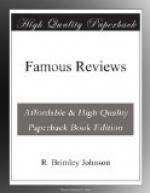It has been generally supposed that in the case of these as of other successful novels, the most prominent and peculiar characters were sketched from real life. It was only after the death of Smollet, that two barbers and a shoemaker contended about the character of Strap, which each asserted was modelled from his own: but even in the lifetime of the present author, there is scarcely a dale in the pastoral districts of the southern counties but arrogates to itself the possession of the original Dandie Dinmont. As for Baillie Mac Wheeble, a person of the highest eminence in the law perfectly well remembers having received fees from him.
* * * * *
Although these strong resemblances occur so frequently, and with such peculiar force, as almost to impress us with the conviction that the author sketched from nature, and not from fancy alone; yet we hesitate to draw any positive conclusion, sensible that a character dashed off as the representative of a certain class of men will bear, if executed with fidelity to the general outlines, not only that resemblance which he ought to possess as “knight of the shire,” but also a special affinity to some particular individual. It is scarcely possible it should be otherwise. When Emery appears on the stage as a Yorkshire peasant, with the habit, manner, and dialect peculiar to the character, and which he assumes with so much truth and fidelity, those unacquainted with the province or its inhabitants see merely the abstract idea, the beau ideal of a Yorkshireman. But to those who are intimate with both, the action and manner of the comedian almost necessarily recall the idea of some individual native (altogether unknown probably to the performer) to whom his exterior and manners bear a casual resemblance. We are therefore on the whole inclined to believe, that the incidents are frequently copied from actual occurrences, but that the characters are either entirely fictitious, or if any traits have been borrowed from real life, as in the anecdote which we have quoted respecting Invernahyle, they have been carefully disguised and blended with such as are purely imaginary. We now proceed to a more particular examination of the volumes before us.




